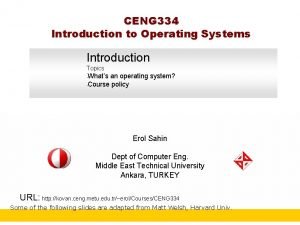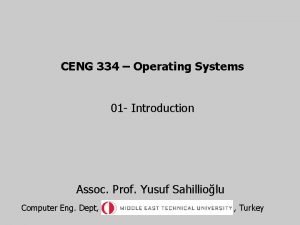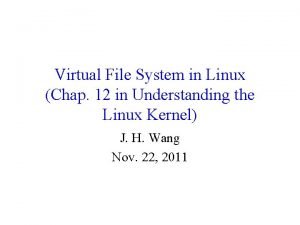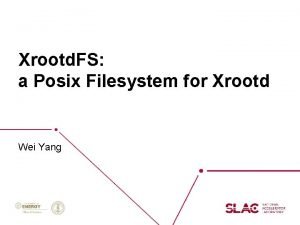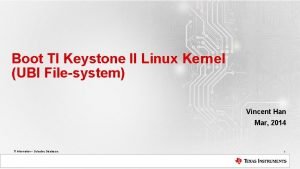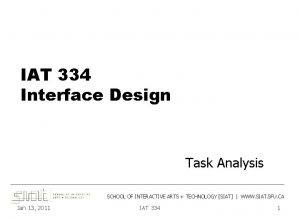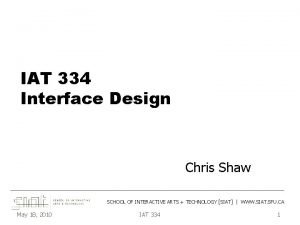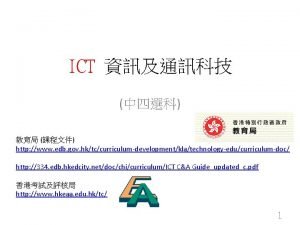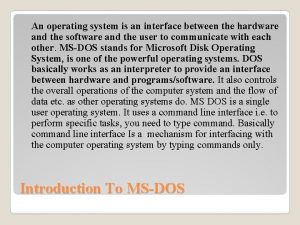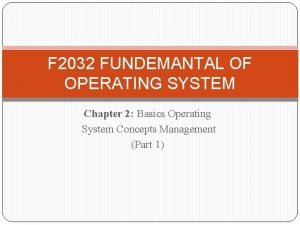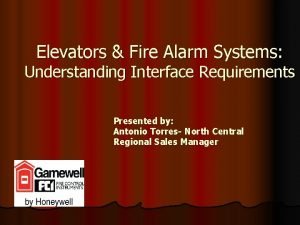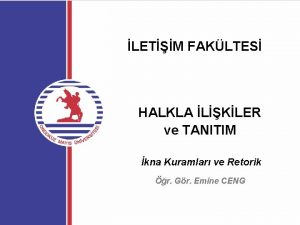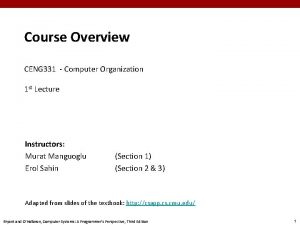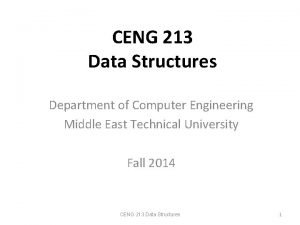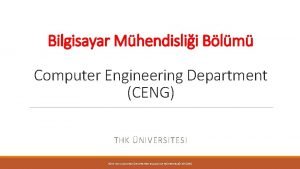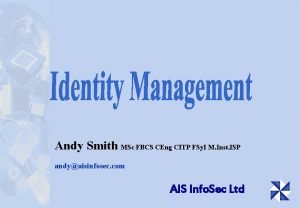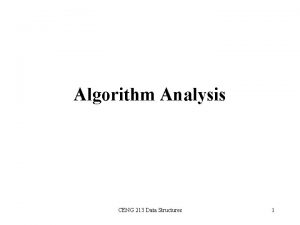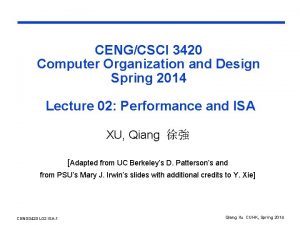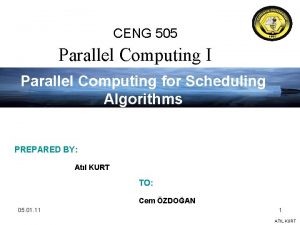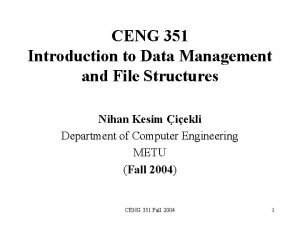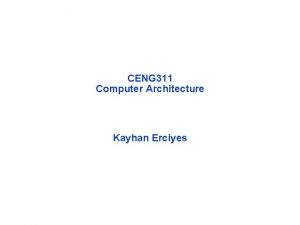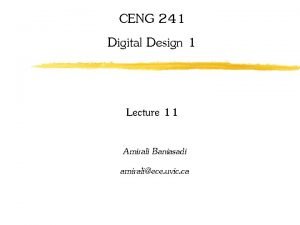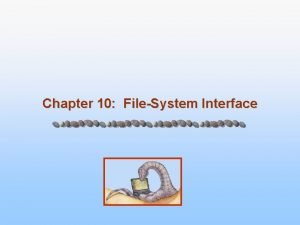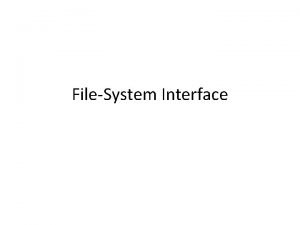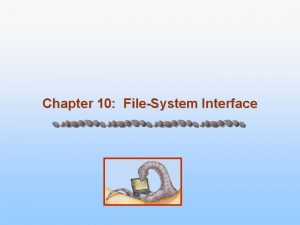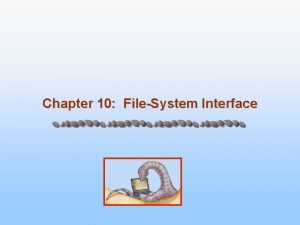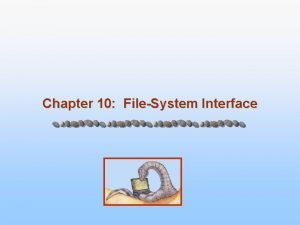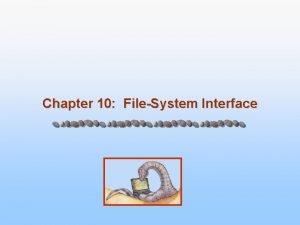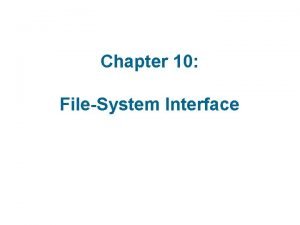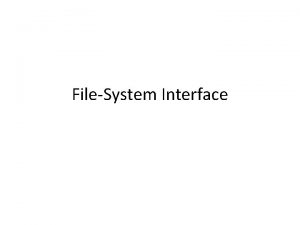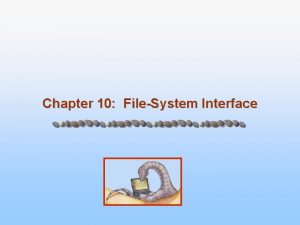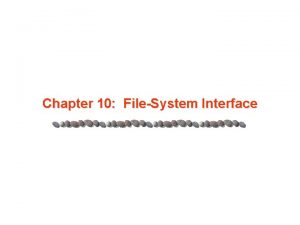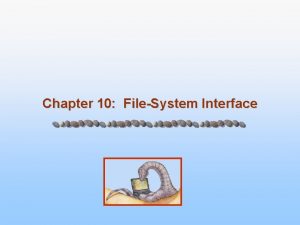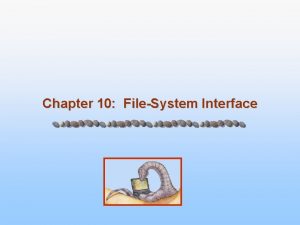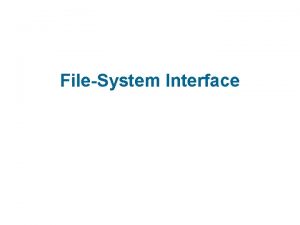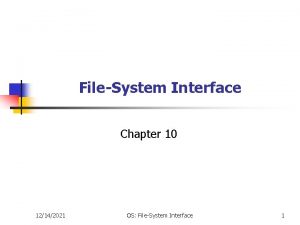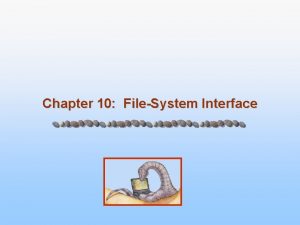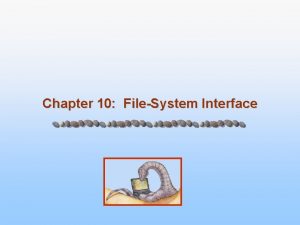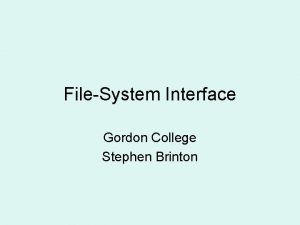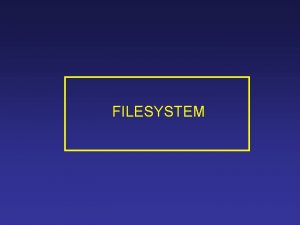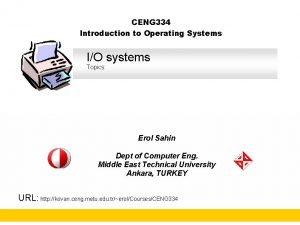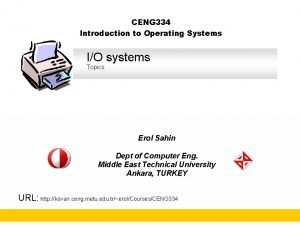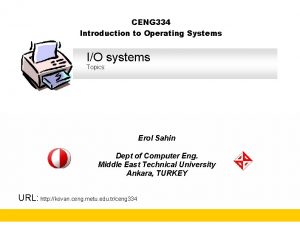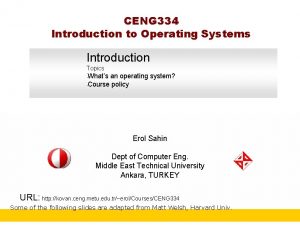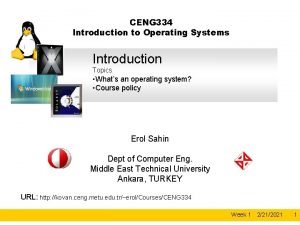CENG 334 Introduction to Operating Systems Filesystem Interface

































- Slides: 33

CENG 334 Introduction to Operating Systems File-system Interface Topics: Erol Sahin Dept of Computer Eng. Middle East Technical University Ankara, TURKEY

Chapter 10: File-System Interface To explain the function of file systems File Concept To describe the interfaces to file systems Access Methods To discuss file-system design tradeoffs, including access methods, file sharing, file locking, and directory structures To explore file-system protection Directory Structure File-System Mounting File Sharing Protection 2

File Concept File is a logical storage unit abstraction provided by the operating system. Files are mapped by the operating system onto physical devices (disks, tapes, CDs, etc. . ) From the user point of view, file is the only unit through which data can be written onto storage devices. The information in a file as well as the attributes of the file is determined by its creator. Data numeric character binary Program When a file is created, it becomes independent of the process, the user and even the system that created it. 3

File Attributes Name – only information kept in human-readable form Identifier – unique tag (number) identifies file within file system Type – needed for systems that support different types Location – pointer to file location on device Size – current file size Protection – controls who can do reading, writing, executing Time, date, and user identification – data for protection, security, and usage monitoring Information about files are kept in the directory structure, which is maintained on the disk 4

File Operations File is an abstract data type and the OS provides a number of minimal operations on it. Create Allocate space and then make an entry in the directory Write Requires name of the file, and the information to be written Search the directory to find file’s location. Keep a write-pointer to the location in the file Update the pointer after each write Read File-position Requires name of the file, and the information to be read pointer Search the directory to find file’s location. Keep a read-pointer to the location in the file Update the pointer after each read Reposition within file Change the value of the file-position pointer Delete Deallocate the space and remove the entry Truncate Change the allocated space to zero, and deallocate its space 5

Open Files Most file operations require searching the directory for the entry associated with the file. To avoid this constant search, most systems require that file be “open”ed, before its use. Open(Fi) – search the directory structure on disk for entry Fi, and move the content of entry to memory Close (Fi) – move the content of entry Fi in memory to directory structure on disk Several pieces of data are needed to manage open files: File pointer: pointer to last read/write location, per process that has the file open File-open count: counter of number of times a file is open – to allow removal of data from open-file table when last processes closes it Disk location of the file: cache of data access information Access rights: per-process access mode information 6

File Types – Name, Extension The filetype provides information on what can be done with that file to the OS. Typically implemented as the extension of the filename. In UNIX systems, a crude “magic number” is stored at the beginning of some files to indicate the type of the file (executable/shell script. . ) In Mac OS X, each file has a type TEXT/APPL. Each file also has a creator attribute that is set to the program that created it. 7

File Structure None - sequence of words, bytes This is the structure supported by UNIX systems Simple record structure Lines Fixed length Variable length Complex Structures Formatted document Relocatable load file Can simulate last two with first method by inserting appropriate control characters Who decides: Operating system Program 8

Open File Locking Provided by some operating systems and file systems Mediates access to a file Mandatory or advisory: Mandatory – access is denied depending on locks held and requested Advisory – processes can find status of locks and decide what to do 9

Access Methods Sequential Access read next write next reset no read after last write (rewrite) Direct Access (available when the file is made up of fixed-length logical records, useful in databases) read n write n position to n read next write next rewrite n n = relative block number 10

Directory Structure A collection of nodes containing information about all files Directory Files F 1 F 2 F 3 F 4 Fn Both the directory structure and the files reside on disk Backups of these two structures are kept on tapes 11

A Typical File-system Organization Partition/volume/minidisk: A chunk of storage that holds a filesystem. It contains information about the files in a directory. 12

Operations Performed on Directory A directory is effectively a symbol table that translates file names into their directory entries. Search for a file Given a name or a pattern of names, we should be able to find all the files that use it. Create a file touch assignment 3. c Delete a file rm assignment 3. c List a directory ls Rename a file mv assignment 3. c odev 3. c Traverse the file system cd include 13

Organize the Directory (Logically) to Obtain Efficiency – locating a file quickly Naming – convenient to users Two users can have same name for different files The same file can have several different names Grouping – logical grouping of files by properties, (e. g. , all Java programs, all games, …) 14

Single-Level Directory A single directory for all users Naming problem: Who will use the name assignment 3. c? Each student has to use a different name: e 123456 assignment 3. c Grouping problem Listing would be very crowdy. 15

Two-Level Directory Separate directory for each user Path name In MS-DOS, C: userxtest. bat In VMS, volume: [userx. home]test. bat; 1 Can have the same file name for different user Efficient searching No grouping capability 16

Tree-Structured Directories A directory is simply another file that needs to be treated in a special way. 17

Tree-Structured Directories (Cont) Efficient searching directory entry sizes would be manageable Grouping Capability Current directory (working directory) cd /spell/mail/prog type list 18

Tree-Structured Directories (Cont) Absolute or relative path name Creating a new file is done in current directory Delete a file rm <file-name> Creating a new subdirectory is done in current directory mkdir <dir-name> Example: if in current directory /mail mkdir count mail prog copy prt exp count Deleting “mail” deleting the entire subtree rooted by “mail” 19

Acyclic-Graph Directories Have shared subdirectories and files 20

Acyclic-Graph Directories (Cont. ) Two different names (aliasing) If dict deletes list dangling pointer Solutions: Backpointers, so we can delete all pointers Variable size records a problem Backpointers using a daisy chain organization Entry-hold-count solution New directory entry type Link – another name (pointer) to an existing file Resolve the link – follow pointer to locate the file 21

General Graph Directory 22

General Graph Directory (Cont. ) How do we guarantee no cycles? Allow only links to file not subdirectories Garbage collection Every time a new link is added use a cycle detection algorithm to determine whether it is OK 23

File System Mounting A file system must be mounted before it can be accessed A unmounted file system is mounted at a mount point 24

File Sharing of files on multi-user systems is desirable Sharing may be done through a protection scheme On distributed systems, files may be shared across a network Network File System (NFS) is a common distributed file-sharing method 25

File Sharing – Multiple Users User IDs identify users, allowing permissions and protections to be per-user Group IDs allow users to be in groups, permitting group access rights 26

Protection File owner/creator should be able to control: what can be done by whom Types of access Read Write Execute Append Delete List 27

Access Lists and Groups Mode of access: read, write, execute Three classes of users RWX a) owner access 7 RWX b) group access 6 RWX c) public access 1 110 001 Ask manager to create a group (unique name), say G, and add some users to the group. For a particular file (say game) or subdirectory, define an appropriate access. owner chmod group 761 public game Attach a group to a file chgrp G game 28

Windows XP Access-control List Management 29

A Sample UNIX Directory Listing 30

File Sharing – Remote File Systems Uses networking to allow file system access between systems Manually via programs like FTP Automatically, seamlessly using distributed file systems Semi automatically via the world wide web model allows clients to mount remote file systems from servers Client-server Server can serve multiple clients Client and user-on-client identification is insecure or complicated NFS is standard UNIX client-server file sharing protocol CIFS is standard Windows protocol Standard operating system file calls are translated into remote calls Distributed Information Systems (distributed naming services) such as LDAP, DNS, NIS, Active Directory implement unified access to information needed for remote computing 31

File Sharing – Failure Modes Remote file systems add new failure modes, due to network failure, server failure Recovery from failure can involve state information about status of each remote request Stateless protocols such as NFS include all information in each request, allowing easy recovery but less security 32

File Sharing – Consistency Semantics Consistency semantics specify how multiple users are to access a shared file simultaneously Similar to Ch 7 process synchronization algorithms Tend to be less complex due to disk I/O and network latency (for remote file systems Andrew File System (AFS) implemented complex remote file sharing semantics Unix file system (UFS) implements: Writes to an open file visible immediately to other users of the same open file Sharing file pointer to allow multiple users to read and write concurrently AFS has session semantics Writes only visible to sessions starting after the file is closed 33
 Ceng334
Ceng334 Ceng 334
Ceng 334 Pathname lookup in linux's virtual filesystem
Pathname lookup in linux's virtual filesystem Posix filesystem
Posix filesystem Ubi filesystem
Ubi filesystem Iat 334
Iat 334 Iat 334
Iat 334 334.edb. hkedcity. net/curriculum
334.edb. hkedcity. net/curriculum Love story 334
Love story 334 Iat 102
Iat 102 8663392432
8663392432 Open source operating system
Open source operating system What is interface in java
What is interface in java User led through interaction via series of questions
User led through interaction via series of questions Office interface vs industrial interface
Office interface vs industrial interface Interface------------ an interface *
Interface------------ an interface * Operating system provides interface between
Operating system provides interface between Operating system and user interface
Operating system and user interface Interface fire alarm systems and elevator controls
Interface fire alarm systems and elevator controls Communication interface in embedded systems
Communication interface in embedded systems Emine ceng
Emine ceng Ceng 考牌
Ceng 考牌 Cow ceng metu
Cow ceng metu Imeche ceng application example pdf
Imeche ceng application example pdf Cow ceng metu
Cow ceng metu Thkü bilgisayar mühendisliği
Thkü bilgisayar mühendisliği Citp vs ceng
Citp vs ceng Ceng 213
Ceng 213 What is the difference between ethics and law
What is the difference between ethics and law Ceng3420
Ceng3420 505
505 Ceng 351
Ceng 351 Iyte ceng
Iyte ceng Ceng 241
Ceng 241
